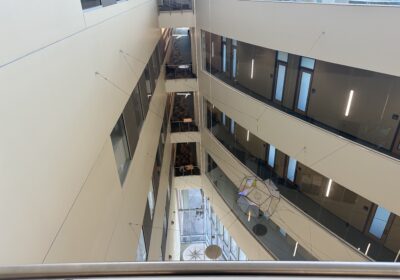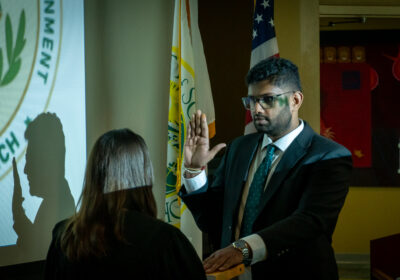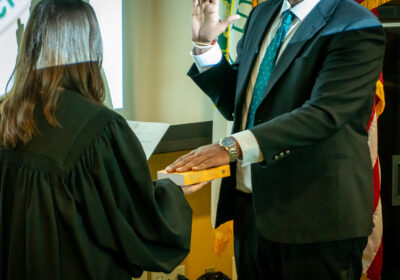A look behind the scenes of the technology fee

ORACLE PHOTO/CHAVELI GUZMAN
Since 2009, USF has charged students a technology fee: A fund that has accumulated millions of dollars over the years for systemwide or campus technology projects.
The fee was established in 2009 by the USF board of trustees in accordance with the Florida Legislature, according to the USF Information Technology (IT) website. Florida statute 1009.24.13 allows each board of trustees to charge up to 5 percent of tuition per credit hour as the tech fee.
“The revenue from this fee shall be used to enhance instructional technology resources for students and faculty,” the statute says.
When USF established its tech fee, it chose the maximum: 5 percent. The 2017-18 undergraduate tuition rate at USF Tampa is $105.07 per credit hour, according to the USF controller’s office. This meant the student tech fee was $5.25 per credit hour. A student taking 15 credit hours would pay $78.75.
Jenny Paulsen, assistant vice president of USF IT, said the fee has been used for a wide variety of projects both systemwide and at the individual USF campuses. These range from putting Wi-Fi on campus to e-books in the library.
“I think all of (the projects) have been quite impactful in one way or another,” Paulsen said.
All of the projects the student tech fee has been used for in the past are posted on the USF IT website. Some of the projects listed include printer replacement in the library, BullSync, student access to Lynda.com and apps.usf.edu. This latter project is one Paulsen said is particularly noteworthy.
“Rather than you as a student having to go and buy these very expensive software packages yourself, the tech fee sponsored the ability for us to provide those software packages to all students through the apps.usf.edu portal,” she said.
The funding for these projects is allocated by USF IT in a series of committees. Of the money students pay for the fee, 25 percent goes to funding systemwide projects, while the remaining 75 percent goes to funding projects on that student’s campus. The divisions for campuses include the three campuses — Tampa, Sarasota-Manatee and St. Petersburg — and also USF Health.
Paulsen said there is a committee established for each entity with student, faculty and staff representation. These representatives are assigned the task of getting requests from their constituents.
“We leave it up to each of them on how they want to do that,” she said. “Some of the committees are standing committees that have other roles as well, so they meet on a regular basis anyway and we hijack some of their meetings for the tech fee.”
The committees are dedicated to the tech fee or can piggyback on other committees. The Tampa committee was purposely formed just for the purpose of the tech fee. The system committee is also the IT Management Committee. The USF Health committee leverages the Health Technology Governance Group for its meetings.
Each entity operates on its own cycle, which lasts for 12 months. These cycles all operate throughout the year and can overlap.
They don’t meet in excess, Paulsen said, usually meeting once near the beginning of the cycle and then once to make decisions on projects. The goal in selecting projects, she said, is to put students first and to align with the mission of the university.
“One of the things that we do encourage is investing in emerging technologies,” Paulsen said. “The tech fee is a source of funding that’s encouraged to be used for trying out new technologies to see whether they do add value or not and if they do we can go on and … make use of that technology in the future.”
Students on campus need varying degrees of technology for the work they do. While some students simply use the printers in the library, students like the members of the Whitehatters computer security club require a little more.
“Some students have more money and a more degree of resources, better computers … but we do have students that can’t afford those resources or it’s not as easy to get and so in those cases we try to provide computing power to those that need it and that requires money,” Brad Daniels, president of the Whitehatters technology club, said.
Right now, most of the computer infrastructure we have was just free donations from individuals who are just friends of the club, but there’s always things that we need. There’s always things that we need more of and so we’re kind of always on the lookout for different sources of funding or resources.”
His club gets its funding from the engineering council within Student Government, which funds the club through activity and services fee. There are many resources the club uses on campus, Daniels said, such as the 3-D printing lab and computer labs for computer science students. However, there are some changes he would like to see.
“What I would really like to see is a computing environment for students where they could create their own virtual machines because that’s really the main thing that I find students are lacking,” he said.
He said the club has considered applying for student tech fee grant, a process he needs to coordinate with faculty advisors who are more familiar with the process. As of right now, the club has never applied for tech fee money.
There are still some resources, however, those like Daniels and the Whitehatters members would like to see. No matter how much or how advanced the technology students at USF are using is, Daniels said he thinks it’s a good idea to have the fee fund technology projects on campus.







